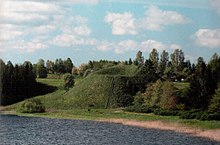Prienai
Prienai (Lithuanian pronunciation: [prʲɪ̂ɛ.nɐɪ̯ˑ] ⓘ) is a city in Lithuania situated on the Nemunas River, 29 km (18 mi) south of Kaunas.
[3] However, the vast majority of archeological findings such as tools and antiquity coins date to the Iron Age, when the region of Prienai was inhabited by early Baltic tribes.
[4] Lush forests, strategically useful valleys, and stunningly beautiful banks of the Nemunas River were among the main reasons why the area became dotted with 28 hillforts, many of which were relatively densely populated thousands of years ago.
In 1609, the city was granted the Magdeburg rights, though they were greatly expanded in 1791 by the Grand Duke of Lithuania Stanislaw II Augustus.
[7] In 1616, the Lithuanian nobleman and politician Stefan Pac, who would later become the Deputy Chancellor of the Grand Duchy of Lithuania, acquired Prienai.
In 1661, Count Gothard Wilhelm Butler, a Lithuanian nobleman of distant Scottish descent, built the Prienai castle.
[9] In the early 18th century, the city somewhat recovered from the devastation of the Great Northern War and in the place of the former castle, the Butler family had built a spacious two-storeyed Baroque styled manor house.
Thanks to the active personal involvement of a priest named Vaitiekus Izdebskis, seventy years later, later a newer and much larger church was built to replace the old one.
[6] After Napoleon defeated Prussia, in 1807, Prussian-occupied Lithuanian territories were transferred to the newly established Polish Duchy of Warsaw.
[13] The Goldberg beer brewery was established back in 1868 and during the interwar period its facilities dominated the urban landscape of the city.
[13] According to local contemporaries, the brewery produced one of the finest beers in Lithuania and its products were regularly exported to Latvia, Poland and the Soviet Union.
[14] In the aftermath of World War II, Prienai was occupied by Soviet Union and its population suffered additional losses.







